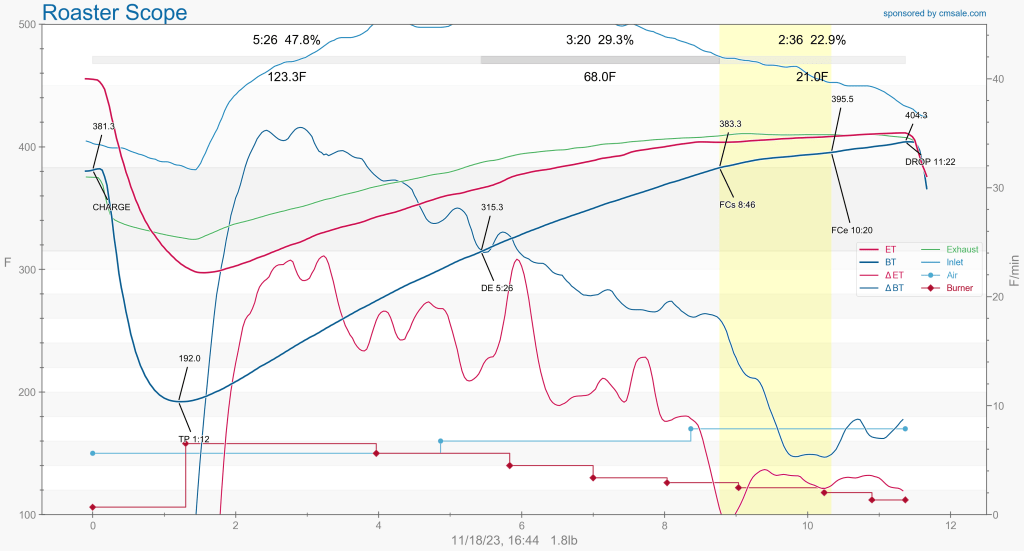It’s been about a year and 8 months since I started moved away from the Hottop and started roasting with the Arc 800 RTD. With over 60 roasts under my belt, the chance to share my thoughts on this roaster is about 50 roasts beyond what I had planned, but better late than never.
The Purchase
I ordered the Arc 800 RTD roaster through Showroom Coffee in late 2021, but due to supply chain issues, it didn’t arrive until April of 2022. This was clearly out the control of Showroom Coffee, but they did a terrific job keeping me informed of the status, and I was happy I purchased it through them. The delay ultimately worked in my favor, as I was able to receive one of the first updated models that used new Resistive Temperature Device (RTD) probes in three of its four temperature probes. RTD probes are able to offer a higher level of precision of temperature measurement and can support higher sampling rates to more precisely identify changes in temperature. As one who spends a lot of time interpreting performance metrics in data centers, I probably appreciated this improvement more than most.
Why did I go with the Arc 800? For me it was the best balance of capabilities, build quality, aesthetic, price and support. There is a fair amount of competition for roasters in this class and batch size. While I don’t have any experience with those other machines, many of them share very similar componentry and design, and I suspect many would have similar operating characteristics.
The walk around
The build quality on the Arc 800 is outstanding. The two Hottop electric roasters I used for nearly a decade prior were made with stamped sheet metal from flat-pattern cutouts, and a fair amount of plastic. It had design compromises that kept upfront costs lower, but limited its capabilities, and serviceability. Contrast that with 115 pounds of milled aluminum, stainless steel, brass fittings, and a carbon steel drum. The quality of the machining and assembly of parts with tight tolerances is found throughout every aspect of the roaster. My curious neighbors remind me that it is quite impressive to look at as well.

My roaster uses Liquid Propane Gas (LPG), but it does support Liquid Natural Gas (LNG) with the appropriate adapter. There is an electric version of the Arc 800, but after coming from an electric roaster, I’m not convinced that one has sufficient control or BTUs for roasting batch sizes that the Arc 800 can handle. I connect the roaster to a 20 pound LPG tank using the 50mbar regular that was new to the Arc 800 RTD. I haven’t had to refill my tank yet, but I expect that to happen within the next 10 roasts. The cyclone chaff collector is extremely effective at collecting chaff, which was a much-improved experience compared to what I was used to.
The Location Setup
This setup is optimized for space and mobility so that future changes can be easily accommodated for. My Arc 800 currently sits on a Harbor Freight service cart, with a butcher block purchased from Home Depot, and mounted on top. I trimmed this top to 32″ x 20″ to keep the space to a minimum. The service cart also holds the propane tank, and I have a fold-out table attachment on the cart for my laptop running Artisan. I decided to forgo any fixed exhaust ductwork through the garage at this moment due to cost of double walled piping, and potential changes in the future. I simply open up the garage door when I’m ready to roast.

The Transition
Aside from the size and aesthetic of it, perhaps the biggest difference in transitioning to an LPG roaster is the thermal output and control. The total amount of BTUs produced by a gas roaster, and the speed at which it can apply the heat is an order of magnitude higher than an electric roaster. The Arc 800 provides up to 16,000 BTUs, that are almost immediately accessible, whereas electric roasters using traditional heating elements are inevitably capped by circuit amperage and provides just a fraction of available BTUs compared to gas powered units.
The transition was a bit overwhelming at first, as there are several variables in your control that simply aren’t available in a small electric roaster. My plan was simple. Define a recipe, monitor the metrics using Artisan, and be prepared to ruin some beans as I got a feel for the unit. While my worst batch was still quite good, what surprised me was the feel that you grow to have after a few dozen roasts. Artisan continues to be an amazing tool for anyone that appreciates data feedback as much as I do, but I have also developed a feel for when the roaster may be a bit behind or reacting a bit differently to a different bean.
The Roasting
Initially I used 500g batch sizes with the Arc, but with more coffee drinkers to support in the household, and giving away beans to friends and family, I have standardized on a 720g batch size, which is the maximum the Arc 800 will support. For me, a 720g batch sizes translates to a roast schedule of about once every 10 days, which is far more convenient than the 250g maximum batch size of the Hottop.
Warmup of the roaster typically is around 35 minutes. I’m sure one could justify a longer warmup time to ensure the heat is thoroughly soaked through the entire thermal mass of the roaster, but I’ve found 35 minutes to be sufficient. Sometimes if it is a bit colder out, I’ll give it a few more minutes. I let the bean temperature probe run up to 425F for a while before I reduce the burner back to let it cool down to my desired drop temperature. I avoid other methods of cooling it down (opening airflow, etc.) since I believe it creates an artificial number that makes understanding the charge temperature more difficult.
Compared to an electric roaster using heating elements, where reaction times to everything is slow, the adjustability and reaction times of the Arc 800 is extremely fast. This can make you feel a bit discombobulated at first when your muscle memory isn’t trained well enough to quickly adjust the burner or airflow. The results, down to how it tastes in the cup is not only superb, but consistent. To my taste, each roast has been wonderful.
The Recipe
Most of my green beans I roast have been washed Colombia and Mexico with other regions and varieties for the occasional change. I typically consume my coffee using my ACS Vesuvius espresso machine, so I usually roast until I’m just shy of, or touching the 2nd crack.
My current recipe is a variation of what is sent with the roaster. I’ve modified it a bit to suit my conditions, and it will probably continue to evolve. Is it a perfect recipe that would be endorsed by a roasting consultant? Probably not. But I use it as a reference point that I can experiment with changing one variable at a time. It does not attempt more recent trends to go with higher burner and airflow combinations to help stabilize the declining rate-of-rise (RoR), but I am interested in experimenting with that technique at some point.
Preheating
I set my airflow to 2, open the gas, and light the roaster. Once lit, the airflow is opened to 2.5, and the burner is so to about 8, and I spend the warmup time distracted by unfinished projects in the garage. Once I’ve hit the 35-minute mark, I pull the gas back to 3 and wait for the bean probe to hit about 380 or 385 for charging.
Charge
The following assumes measurements of the bean temperature probe in Fahrenheit (F).
Step 1: At 385F, drop beans (leaving burner at 3).
Step 2: At turning point, turn up burner to 30.
Step 3: At 270F, set burner at 25.
Step 4: At 300F, open airflow to 3
Step 5: At 325F, set burner to 20
Step 6: At 350F, set burner to 15
Step 7: At 370F, set burner to 13
Step 8: At 372F, open airflow to 3.5 (to reduce flick and crash from pending first crack, which may happen around 380-385F)
Step 9: At 385F, set burner to 11
Step 10: At 395F, set burner to 9
Step 11: At 400F, set burner to 6
Step 12: Drop beans at or before 405F, just before 2nd crack.
Depending on the beans used, and the ambient temperature, the steps above will produce a graph in Artisan that looks something like below.

The Takeaway
If I’ve learned one thing, a gas-powered roaster is in a totally different category than small electric roasters. The Arc 800 RTD is a beautiful roaster that lives up to everything I had hoped for. While there are certainly more affordable options for the casual home roaster, it produces fantastic coffee, appears to be built like a tank, and gives the sense that it will last for many years to come. Would I do it again? Without any hesitation, yes.
